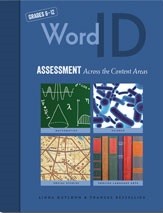Price $19.95
While many assessments exist for content-area vocabulary and comprehension, content-area word identification is often overlooked. Many times it is assumed that students select incorrect answers because of their insufficient content-area knowledge when the failure is actually due to their difficulty in reading multisyllabic words.
Word ID's reliable and valid Three-Step Formative Assessment System helps content-area teachers identify students in grades 6–12 who need instruction in multisyllabic word identification so they can independently read and comprehend their English Language Arts, Mathematics, Science, and Social Studies texts.
Use Word ID with secondary students to:
•Quickly and easily identify students who struggle with or cannot read multisyllabic words in their content-area texts
•Support instruction in reading and comprehending complex texts
•Determine where additional assessment, instruction, or intervention is needed in word identification
•Identify students who need specific instruction in developing their college and career readiness skills
The whole-class screeners and individual diagnostic assessments are tailored to each specific content area to measure students' ability to use knowledge of syllable types, syllable division patterns, and common morphemes (e.g., prefixes, suffixes, Greek roots) to decode multisyllabic words. Based on results, teachers can implement an individual or targeted group intervention in a Response to Instruction (RtI) or another instructional improvement framework.
Determined by ground-breaking research analyzing approximately 4,500 content-area words, Word ID features targeted prefixes, suffixes, and Greek roots that were selected for their frequency of occurrence in each specific content area.
- Copyright 2013

 Proud to be Canadian
Proud to be Canadian